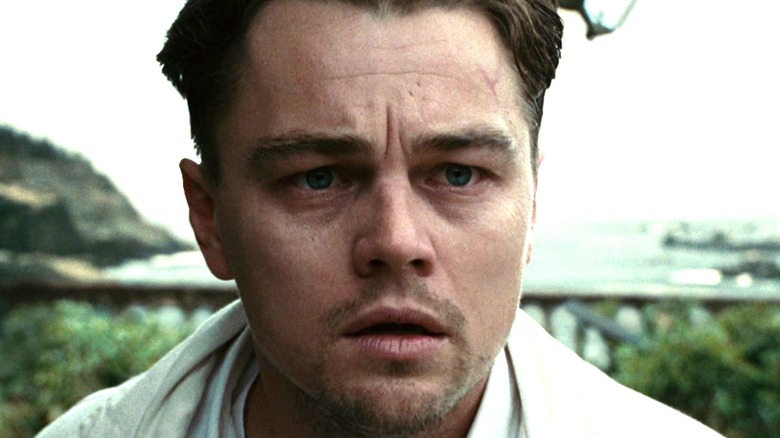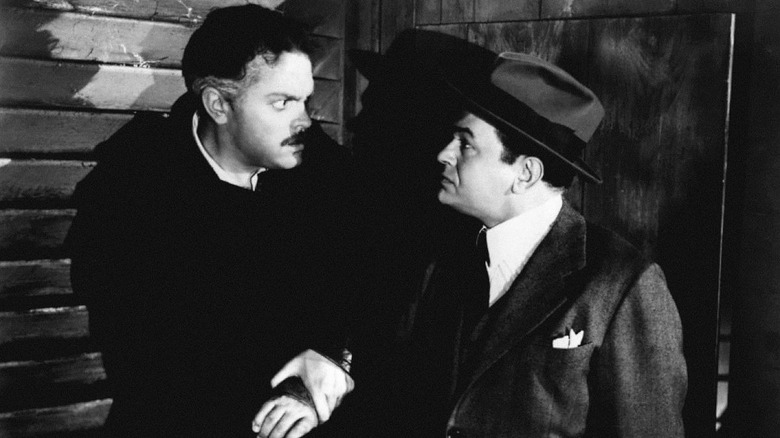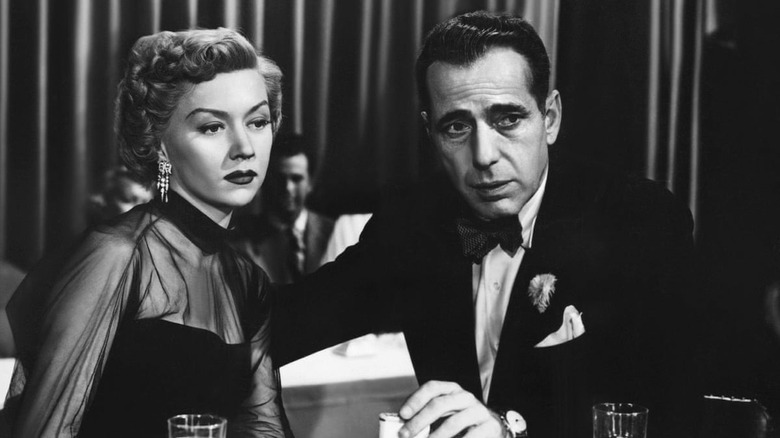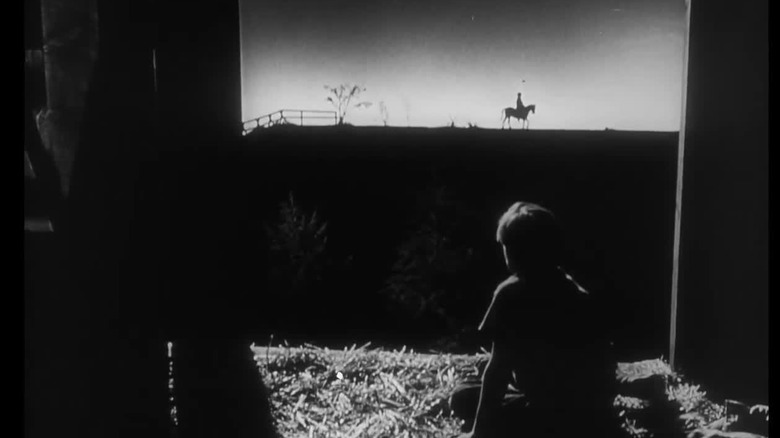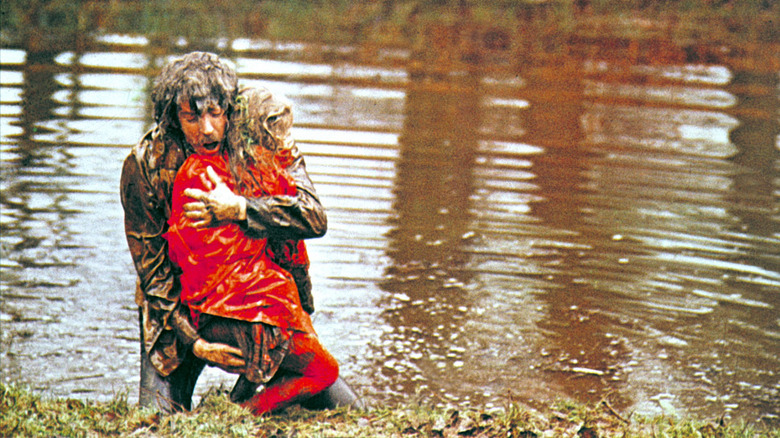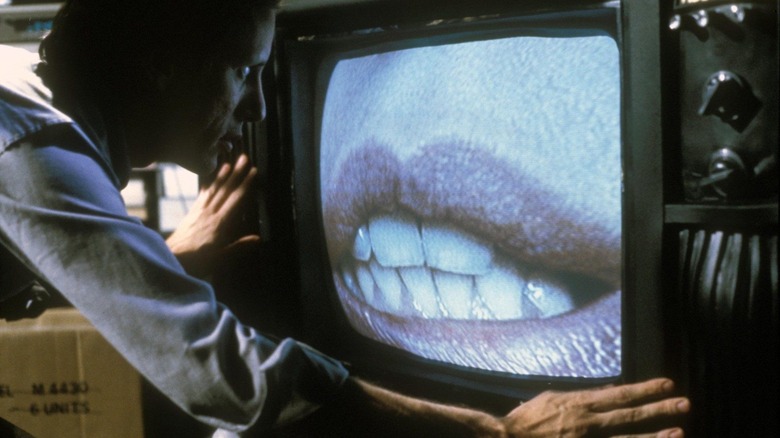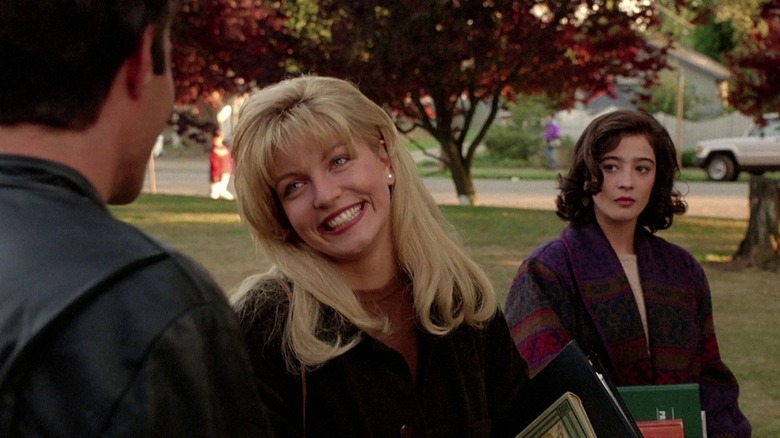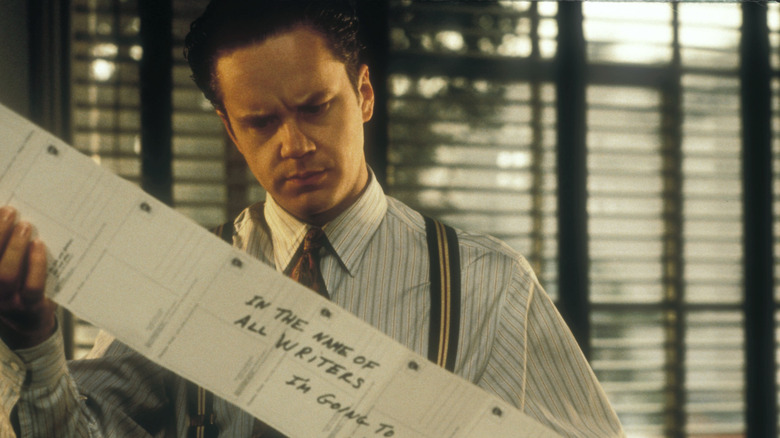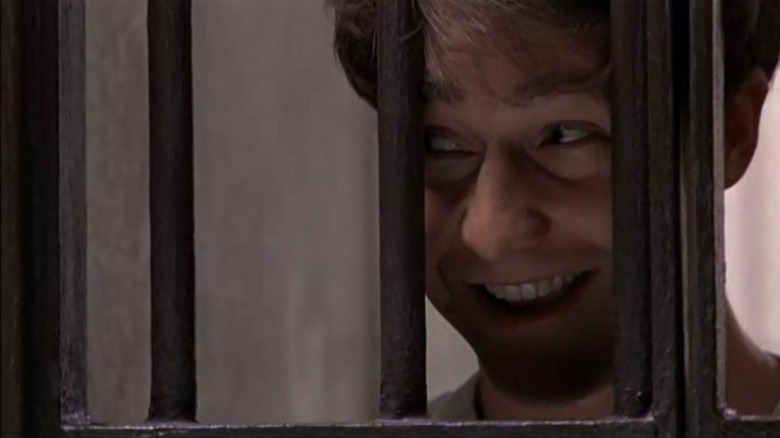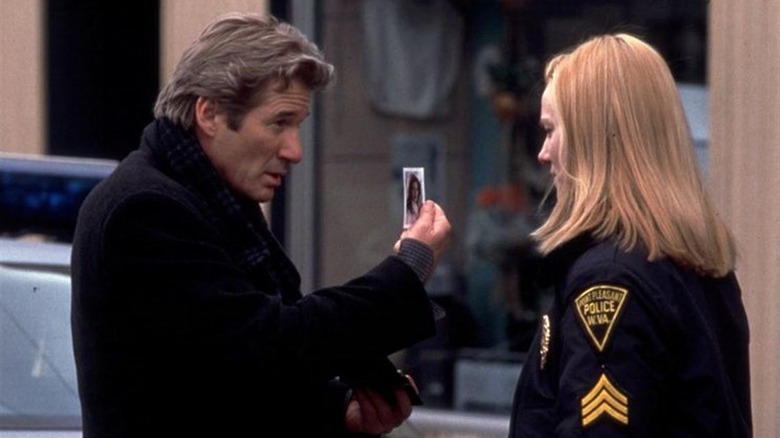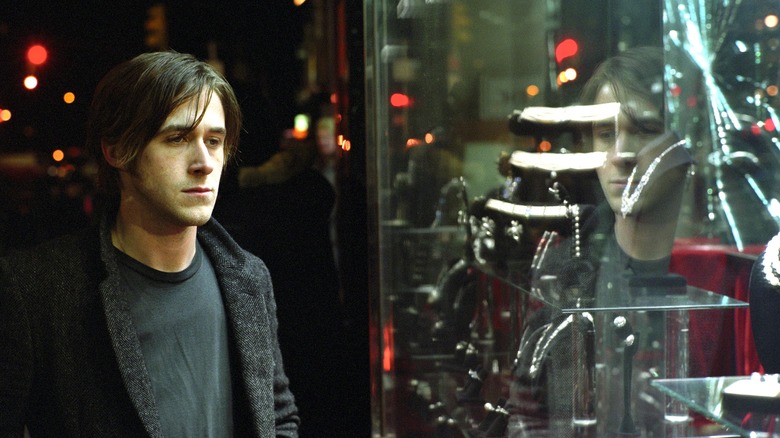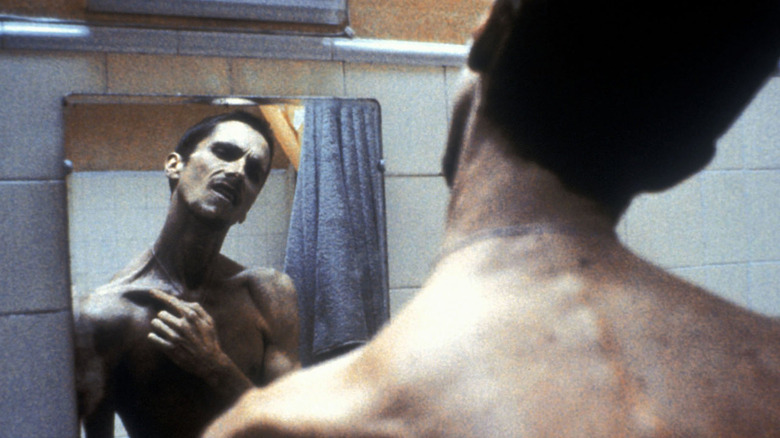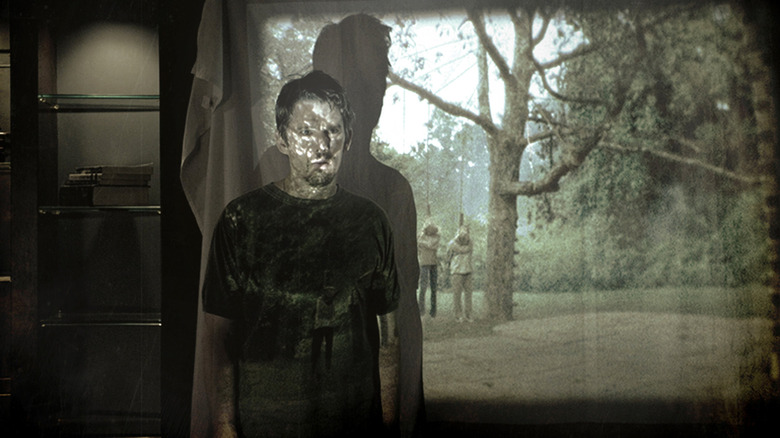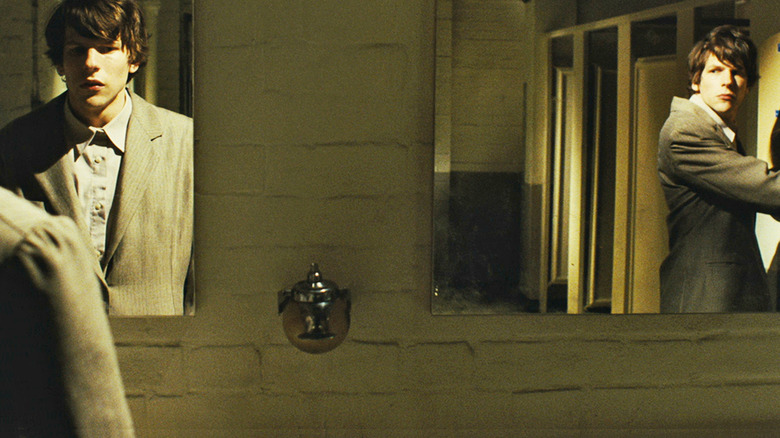13 Movies Like Shutter Island That You Really Need To See
Martin Scorsese's 2010 film "Shutter Island" was an exciting departure from the style that he's best known for. While he's made many different types of movies, Scorsese is best known for his crime dramas — films like "Taxi Driver," "Raging Bull," "Goodfellas," and "Casino" are all considered classics.
However, a psychological horror film with shocking plot twists was new territory for the beloved director. Scorsese had dabbled in horror themes with "Bringing Out the Dead" and "Cape Fear," but "Shutter Island" utilized graphic imagery and challenged both the viewers' and the main character's perspective. As a result, "Shutter Island" is highly rewatchable; upon multiple viewings, it's fun to find the small details hidden throughout the story that foreshadow the eventual twists and turns.
"Shutter Island" also gave Leonardo DiCaprio one of his best roles. DiCaprio showed his range as a traumatized man forced to reckon with the demons of his past. The story follows US Marshal Teddy Daniels (DiCaprio) and his partner Chuck Aule (Mark Ruffalo), who are dispatched on a mysterious mission to the Ashecliffe Hospital for the Criminally Insane, located on the isolated Shutter Island in Boston Harbor. If you loved "Shutter Island," check out these 13 films as well.
The Stranger
One of the most exciting things about "Shutter Island" is how unexpected it was to see a filmmaker of Scorsese's prestige take on a horror film. Directors like John Carpenter, Wes Craven, and Dario Argento are known for their horror film expertise, but "Shutter Island" is an intriguing outlier on Scorsese's filmography. Another one of the greatest filmmakers of all time, Orson Welles, took a similar risk with his 1946 mystery thriller "The Stranger." Welles is best known for his directorial debut "Citizen Kane" and serious Shakespearean dramas, but "The Informer" is an elevated pulp thriller that benefits from Welles' meticulous character building.
"The Informer" starred Welles as the Nazi fugitive Franz Kindler, who flees the authorities pursuing him for war crimes. Kindler knows that he'll be executed if he's caught. When he escapes to the United States, he disguises himself as a prep school professor named Charles Rankin. Kindler bonds with his students, but refuses to share any details about his past when in social situations. As he approaches his upcoming wedding to Mary Longstreet (Loretta Young), Kindler grows terrified that his secret will be discovered. He covertly murders innocents in the Connecticut community to mask his connections to the Nazis.
Similar to DiCaprio's Teddy Daniels, Kindler is an unlikeable character that is nonetheless compelling thanks to Welles' captivating performance, especially when his anxiety grows as his ruse is shattered.
In A Lonely Place
Casting DiCaprio as the terrifying Daniels in "Shutter Island" was a brilliant move, as it subverted expectations for what a serial killer looked like. Although serial killers are often depicted in films as monstrous and inhumane, DiCaprio's inherent charisma is off-putting and makes his brutal activities more shocking. The casting weaponizes DiCaprio's movie stardom. Humphrey Bogart made a similar gamble in 1947, when he traded on his reputation as a hero in films like "Casablanca" and "The Maltese Falcon" to play an untrustworthy character (and possible killer) in "In A Lonely Place."
Bogart stars in the film as Dix Steele, a renowned screenwriter known for his shocking twists and grisly murders. Steele is prone to violent fits of rage, but his new neighbor Laurel Gray (Gloria Grahame) is fascinated by his charismatic personality. She becomes attracted to him, but grows suspicious after several local homicides are reported that recall the events that Steele wrote about.
Bogart does a terrific job forcing the viewer to question his motivations, as he can be very hard to read. Similar to "Shutter Island," director Nicholas Ray doesn't reveal the twist until the final moments.
The Night of the Hunter
Catholic guilt is a recurring theme in Martin Scorsese's films. Scorsese is adamant about his faith, and creates complex scenarios in his stories to explore existential questions about the church. Religion is omnipresent in "Shutter Island," as Teddy questions his capacity for redemption and struggles to suppress his inner darkness. Nightmares inspired by Catholicism are frequently used in horror — the 1955 religious horror film "Night of the Hunter" is one of the scariest movies ever made.
Based on the novel by Davis Grubb, "Night of the Hunter" follows the young Harper children, John (Billy Chapin) and Pearl (Sally Jane Bruce), as they struggle with the imprisonment of their father Ben (Peter Graves). Ben tells his children the location of a secret stash of cash, and forces them to promise not to reveal it until he's released, even to their mother (Shelley Winters). However, their town is uprooted with the arrival of traveling preacher Reverend Harry Powell (Robert Mitchum). Powell becomes popular for his impassioned sermons, but he's secretly a murderous killer who targets the two children in an attempt to find Ben's money.
Mitchum's performance is terrifying. He loudly sings as he travels across the countryside, and justifies his actions by citing Biblical texts. The imagery from director Charles Laughton is also striking; seeing the murders from the children's perspective makes the film even scarier.
Don't Look Now
"Shutter Island" is a devastating portrayal of the complex feelings of loss, but it's not the first frightening film to visualize trauma through metaphorical imagery. Nicolas Roeg's 1973 film "Don't Look Now" does so, too. The horror film follows two parents grieving the death of a child, showing both the immediate aftermath and the months of healing that follow.
Art historian John Baxter (Donald Sutherland) and his wife Laura (Julie Christie) witness the accidental drowning of their daughter Christine (Sharon Williams) at their London country home, a preventable tragedy that they feel guilty for. In the following months, the pair travels to Venice to study an ancient church and restore its artwork. Not only is it a lucrative offer that will extend their careers, but John theorizes that the new, luxurious environment will allow the couple to relax for the first time since the tragedy.
Upon arriving, the couple are questioned by elderly sisters Heather (Hilary Mason) and Wendy (Clelia Matania), who announce themselves as psychics. The Baxters are unnerved yet intrigued by the prospect of communicating with their deceased daughter. As they attempt to forge a connection with the undead, figures of primal evil begin to appear. The dramatic tension is emotionally authentic, but once the horror elements kick in, the characters are forced to relive the worst moment of their lives over and over again.
Videodrome
"Shutter Island" is thrilling because Daniels can't trust the nature of his own reality. He experiences events, situations, and memories that aren't entirely clear, and it's not until the film's shocking conclusion that he uncovers the state of his own delusions. Daniels thought he was a top American agent investigating mental patients. Really, he is under psychological care. As a result, Daniels breaks down and attempts to deny the truth. A loss of control is also a big part of to David Cronenberg's 1983 body horror classic, "Videodrome."
"Videodrome" follows pretentious Toronto television network president Max Renn (James Woods), who creates technically advanced immersion programming. Renn becomes aware of an enigmatic broadcast signal for a program called "Videodrome," which depicts the violent torture, dismemberment, and murder of innocent Malaysian civilians. Renn is fascinated by the graphic content and decides to invest in developing it further, but while he initially believes that the footage is fake, Max learns from a pornographic artist that it's all real.
As Renn investigates "Videodrome," he discovers that it's the face of an extremist movement that preys upon viewers' hidden violent impulses. Some unsuspecting vagrants watch the program for hours on end, and fall completely under its control. Renn soon finds himself helpless to resist "Videodrome" as well. Like Daniels, Renn isn't necessarily a likable character, but his unsuspecting nature makes him sympathetic. Woods is captivating, and Renn's transformation from abusive employer to helpless victim is exhilarating and terrifying.
Twin Peaks: Fire Walk with Me
"Shutter Island" is a landmark entry on Scorsese's filmography because of how surreal the film is. Scorsese is known for the realism he brings to his stories, but "Shutter Island" features bizarre, abstract sequences. David Lynch is perhaps the most famous curator of cinematic surrealism, and often uses dreamlike logic to explore damaged characters.
Lynch's 1992 film "Twin Peaks: Fire Walk with Me" follows an abuse survivor who confronts her inner trauma. "Fire Walk with Me" is a prequel to Lynch's beloved ABC series "Twin Peaks," which was canceled after the conclusion of its second season. However, while the series follows an investigation into the death of high school prom queen Laura Palmer (Sheryl Lee), only slowly revealing Laura's abuse at the hands of her possessed father Leland (Ray Wise), "Fire Walk with Me" depicts characters and events that fans are already aware of, telling the story from Laura's perspective for the first time.
Like Daniels, Laura isn't immediately aware of what's happening to her. When possessed, her father is replaced by the killer BOB (Frank Silva), and it's not until Laura's final moments that she realizes the identity of her abuser. "Fire Walk with Me" is often grueling to watch due to Lee's terrified performance, but it's also considered one of Lynch's best films for a good reason.
The Player
"Shutter Island" is effective because of its gradual escalation of violence. Instead of shocking immediately with graphic kills and jump scares, Scorsese creates tension through a deliberate pace. Robert Altman's brilliant 1992 satire "The Player" takes a similar approach, despite wildly different subject material. "The Player" is far more humorous and satirizes Hollywood corruption, but like "Shutter Island" it features a murderous lead character who doesn't fit the mold of a traditional killer.
Los Angeles studio executive Griffin Mill (Tim Robbins) lives a luxurious life, and aims to make a name for himself in the film industry by crafting the next box office smash. Mill listens to pitches from countless screenwriters and dismisses them with casual cruelty; he promises to return their calls, but doesn't, and fakes his enthusiasm. Mill has never been held responsible for his behavior until he gets a mysterious letter from a former client threatening to kill him. Mill becomes obsessed with remembering which screenwriter he set off, and sets out to find his secret tormentor. He tracks down David Kahane (Vincent D'Onofrio) and kills him, covering his tracks. Realizing that he has the power to mask his crimes, Mill continues killing to eliminate his competitors in the industry.
"The Player" explores many of the same themes as "Shutter Island," as both films deal with complicated men who discover their inner brutality. Mill only needs one taste of blood to find his aptitude for violence, which only grows as investigators close in on Mill's location.
Primal Fear
"Shutter Island" has one of the most shocking plot twists in recent memory. A perfectly executed twist is rare, as filmmakers must incorporate subtle clues throughout the movie without making the reveal obvious. A similar thrill comes from the 1996 courtroom drama "Primal Fear," which has one of the greatest plot twists of all time. The appalling final moments of the film force the viewer to reconsider their perception of the entire story.
"Primal Fear" follows Chicago defense attorney Martin Vail (Richard Gere), who is hired to defend adolescent altar boy Aaron Stampler (Edward Norton), who is accused of murdering a priest. Stampler is extremely nervous and has a distinctive stammer. Vail initially believes in Stampler's innocence, but further research into the case uncovers that he was a victim of sexual abuse by the deceased Archbishop Rushman (Stanley Anderson). Further, traumatic situations cause Aaron to switch into an entirely different person, known as "Roy."
The tension of whether Aaron or Roy is in control creates suspense throughout "Primal Fear." Norton's breakthrough debut performance is unpredictable, and he received an Academy Award nomination for best supporting actor. Similar to DiCaprio in "Shudder Island," Norton brings emotional trauma to life in a respectful way, but not at the expense of the story's pulpier elements.
The Mothman Prophecies
The plausibility of "Shutter Island" makes its scares more effective, almost like it's based on real events. Similarly, although it has some supernatural elements, the 2002 psychological thriller "The Mothman Prophecies" is loosely based on a true story. The actual facts that inspired the mystery are disturbing on their own, interwoven with a fascinating unresolved case that explores the chaotic unpredictability of disasters.
Newspaper columnist John Klein (Richard Gere) suffers an unexpected tragedy when his wife Mary (Debra Messing) is killed in a car accident. Mary had been avoiding a dark, monstrous figure, and Klein can't understand what she saw in her final moments. The only clue that he has is a terrifying primal drawing that Mary left on her deathbed. Klein tries to forget the events, but he's reminded of them two years later when he stumbles on the West Virginia town Point Pleasant, where the isolated community has reported sightings of a creature that matches Mary's description.
Klein becomes obsessed with the similarities, and feels that it is his destiny to solve the case. Both "Shutter Island" and "The Mothman Prophecies" weaponize unnerving parallels to make their horror more effective; Klein only discovers Point Pleasant after inexplicably going miles off of his original course.
Stay
Although the events are fictionalized, "Shutter Island" explores real psychological issues like denial and false realities. Daniels is unaware that medical professionals are helping him process his own guilt. The highly underrated 2005 film "Stay" poses similar questions regarding the perception of truth and how tragedy is perceived. In addition, "Stay" also uses a twist to subvert the audience's and the characters' point of view.
In "Stay," Dr. Sam Foster (Ewan McGregor) is assigned to help a young man named Henry Letham (Ryan Gosling) confront his suicidal thoughts. However, Foster is surprised to learn that Henry doesn't intend to kill himself, but rather hears voices in his head prophesying his own demise. Foster becomes invested in saving Henry's life, and is struck by an unusual series of clues: Henry's previous psychologist has gone insane, and in a fit of madness, his own mother doesn't recognize him.
"Shutter Island" was a box office hit and drew critical acclaim, but, unfortunately, "Stay” received poor reviews and underperformed financially. The analysis-worthy film deserves another look from fans, as its construction is far more clever than some may expect.
The Machinist
Leonardo DiCaprio is one of the greatest actors working today, and "Shutter Island" features a brave performance that ranks among his best. DiCaprio had the challenge of forcing the viewer to empathize with him before his unspeakable crimes are revealed. Few current actors have DiCaprio's range, but Christian Bale is one of them, and he delivered one of his most complex performances in the 2004 psychological thriller "The Machinist."
Bale stars as the insomniac machinist Trevor Reznik, who becomes distracted by the mysterious appearance of a man named Ivan (John Sharidan). Ivan speaks only in cryptic messages and begins to wreak havoc with Trevor's life, eventually causing a serious accident in the factory where Trevor works, leaving one of his fellow operators critically injured. The fatigued Trevor is blamed, and he becomes obsessed with finding Ivan. Events from Trevor's life are shown in flashback, and the nonlinear timeline doesn't reveal the truth until the end.
Sinister
"Shutter Island" is incredibly visceral, and the flashback sequence depicting the drowning of Daniels' wife and children is very upsetting to watch. It's not a film for the faint of heart. Neither is Scott Derrikson's 2012 horror film "Sinister." "Sinister" unveils ritual murders in explicit detail. It's one of the rare modern horror films that uses jump scares effectively, particularly during the now-iconic lawnmower murder.
Renowned true crime author Ellison Oswalt (Ethan Hawke) moves his family to Pennsylvania to investigate an unsolved case that he plans to spotlight with his latest project. However, Ellison's wife Tracy (Juliet Rylance) is uneasy about his decision to live in the same home where an entire family was murdered. While there, Oswalt discovers a series of Super 8 movies of the killings, and notices that symbols recur in five videos. Derrikson creates tension by removing any safe environments; with their place of residence haunted, the Oswalts are under constant threat from the spirits that lurk in the shadows.
The Double
The experimental filmmaking techniques Scorsese uses in "Shutter Island" make the story unpredictable, as there are intentional continuity errors that hint at Daniels' condition. The British black comedy "The Double" uses similar off-putting elements to hint at its central character's paranoia and anxiety. In "The Double," writer-director Richard Ayoade uses the philosophy of Fyodor Dostoyevsky to search for meaning within the unexplained.
Simon James (Jesse Eisenberg) is an unaccomplished desk worker who can't muster the courage to ask out his crush Hannah (Mia Wasikowska). He's shocked when Hannah is courted by a doppelgänger who goes by the name "James Simon." Simon is helpless to prevent his clone from taking over his life, as no one in his office seems to notice the similarities between them. Eisenberg is often cast as nervous characters, so it's fascinating to watch him play both hapless and confident at once.
"The Double" is minimalistic, with stark visuals set in only a few locations. The disparity between its existentialist themes and the quirky humor is a fascinating blending of genre that "Shutter Island" fans should enjoy.
